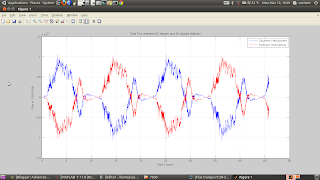Posting some results on my Birthday!
A simulation was run yesterday, with a modified profile of no. of BMRs (Unsigned Flux=2X10^21 Mx) errupting V/s time as below:
Total BMRs per cycle: 7630
The total flux between 2 latitudes was calculated by integrating the product of longitudinally averaged magnetic field and the area of a grid element at that latitude.
Flux=Sum[Bavg(lat)*area(lat)]
Flux between any 2 latitudes was thus calculated at regular intervals, and the difference between flux at 2 different times would give us the change in flux, meaning the flux transported. This difference can be interpreted as flux flowing in the concerned region. It can be both positive and negative.
BUTTERFLY DIAGRAM
Peak Polar Field: +/- 11 Gauss
The initial polar field in the northern hemisphere was negative, and that in the southern hemisphere was positive.
- 0-5 :
So, the flux transported to the equator from above 5 degrees latitude would be negative in the northern hemisphere, and positive in the southern. This flux gets cancelled across the equator.
Remember that the calculation of flux transport here, shows the net flux flowing into the concerned region. So, this plot suggests that there is a flow of negative flux(leading polarity) into the northern region, and flow of positive flux(leading polarity) into the southern region. Both flow towards the equator, where these fluxes cancel each other.
The net flux in the region of 5 degrees from the equator can reach the order of 1-2 sunspots.
2. 10-20 :
The flux transport from 10-20 degree latitudes is negative in the northern hemisphere initially, and then becomes positive after half cycle. This is because the BMRs errupt at higher latitudes initially, hence the leading polarity crosses this region on its way to the equator. But, later on, BMRs start appearing at lower latitudes, which results in a net transfer of trailing polarity flux to the poles.
The net flux in this region can reach the order of 1.5X10^22 Mx.
3. 20-30 :
The trailing polarity flux from lower latitudes enters this region, signified by positive peaks in the northern hemisphere (1st cycle) and negative peaks in the southern hemisphere.
The net flux in this region can reach the order of 4X10^21 Mx.
4. 30-40 :
In this region, there is just about no erruption of BMRs. So, this is like a come and go region for flux. The plot here is plotted with the unsigned difference in net flux for simplicity. Positive peaks indicate the trailing polarity flux entering the region, and negative peaks indicate, that a net flux from leading polarities has entered the region. Overall, there is a negligible storage of trailing polarity flux in this region.
The net flux in this region can reach the order of 6X10^21 Mx.
5. 40-50 :
There is a lot of addition and subtraction of flux in this region during a solar cycle. A positive peak in the flux transport (1st cycle) indicates the trailing polarity reaching the region, and negative peak indicates that the leading polarity flux has entered the region. Overall, there is a small net accumulation of flux from the trailing polarity in this region.
The net flux in this region can reach the order of 8X10^21 Mx.
6. 50-60 :
This region comprises partly of the polar field. The plot shows, that there is always a positive net flux reaching this region in the first cycle, which cancels the previous field, and builds up a new one. Then, for the next cycle, there a negative flux reaching this region at all times. So, the net flux in this region does not show more than one peak. If it is increasing, it will increase till the highest value, and if it is decreasing, it will decrease till the lowest value.
The net flux in this region can reach the order of 2.5X10^22 Mx.














Sushant,
ReplyDeleteGreat work. A very productive Birthday I must say! May you have a wonderful year ahead.
Dibyendu.
Thank you very much Sir...
DeleteReally, an appreciable work at your age, So keep continue..... You need to focus on to solve some fundamental problems in solar physics.
ReplyDelete